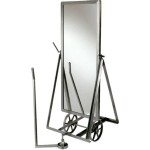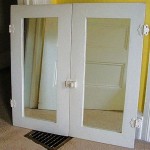How to Hang a Heavy Mirror Without Damaging Your Wall
Hanging a heavy mirror can be a daunting task. Improper installation can lead to wall damage, and in the worst-case scenario, a shattered mirror. This guide provides a comprehensive approach to safely and securely hang heavy mirrors without causing damage to the wall.
Assessing Your Mirror and Wall
Before beginning, understanding the weight and dimensions of the mirror and the wall's construction is crucial. This information dictates the appropriate hanging method.
- Weigh the Mirror: Use a bathroom scale to accurately determine the mirror's weight. Digital scales tend to offer greater precision.
- Measure the Mirror: Accurate measurements are vital for selecting appropriately sized hardware and locating studs for secure mounting.
- Identify Wall Type: Determine if the wall is drywall, plaster, concrete, or another material. This informs anchor selection and installation techniques.
- Locate Studs: Use a stud finder to mark the studs' locations. Hanging heavy objects directly on studs provides the most secure support.
Choosing the Right Hanging Hardware
Selecting the appropriate hardware is paramount for safe and secure mirror hanging. The hardware’s weight capacity should significantly exceed the mirror’s weight.
- Heavy-Duty D-Rings or Wire: For extremely heavy mirrors, D-rings attached to a robust wire and heavy-duty picture hooks are recommended.
- French Cleats: French cleats offer excellent weight distribution and are suitable for large, heavy mirrors. They consist of two interlocking pieces of wood, one attached to the wall and the other to the back of the mirror.
- J-Hooks: J-hooks offer a discreet hanging solution for mirrors with pre-installed hanging hardware. Ensure the J-hooks are rated for the mirror's weight.
- Mirror Mounting Clips: These clips are secured to the wall and grip the bottom and sides of the mirror, providing additional support.
Selecting Appropriate Anchors
Wall anchors are essential for reinforcing the hanging points, especially in drywall or plaster walls.
- Toggle Bolts: Toggle bolts are ideal for heavy objects in hollow walls. They provide a strong hold by expanding behind the wall surface.
- Molly Bolts: Similar to toggle bolts, molly bolts also expand behind the wall, offering a secure anchor point.
- Heavy-Duty Wall Anchors: These plastic anchors can support substantial weight and are suitable for various wall types.
- Concrete Screws: For concrete walls, use concrete screws designed specifically for heavy-duty applications. Predrilling pilot holes is crucial for proper installation.
Preparing the Wall and Mirror
Proper preparation ensures a smooth and successful installation process.
- Mark Hanging Points: Precisely mark the locations for the hanging hardware on both the wall and the back of the mirror.
- Pre-Drill Holes (if necessary): Depending on the wall type and anchor choice, pre-drilling pilot holes is often necessary to prevent wall damage and ensure proper anchor installation.
- Install Wall Anchors: Carefully install the chosen wall anchors, following the manufacturer's instructions.
- Attach Hanging Hardware to the Mirror: Securely attach D-rings, wire, French cleats, or other chosen hardware to the back of the mirror, ensuring they are level and evenly spaced.
Hanging the Mirror
With the preparations complete, carefully hang the mirror.
- Enlist Assistance: For large, heavy mirrors, having a helper is highly recommended to prevent accidents and ensure proper alignment.
- Carefully Lift and Position: Carefully lift the mirror and align the hanging hardware with the wall anchors or hooks.
- Check for Stability: Gently tug on the mirror to ensure it is securely mounted. If any movement or instability is detected, re-evaluate the installation and make necessary adjustments.
Additional Tips for Hanging Heavy Mirrors
Consider these additional tips for a successful installation.
- Use a Level: Ensure the mirror hangs straight by using a level throughout the installation process.
- Protective Padding: Place protective padding between the mirror and the wall at the bottom corners to prevent scratching the wall.
- Consider a Mirror Mastic: For added security, especially with very heavy mirrors, consider applying mirror mastic to the back of the mirror before hanging. This adhesive helps secure the mirror to the wall and provides extra support.
Safety Precautions
Safety should be a primary concern throughout the entire process.
- Wear Gloves: Protect your hands from sharp edges and splinters.
- Eye Protection: Wear safety glasses to protect your eyes from dust and debris.
- Proper Lifting Technique: Lift with your legs, not your back, to avoid injury.

3 Simple Ways To Hang A Mirror On Wall Without Nails Wikihow
How To Hang A Heavy Mirror On Drywall Without Damaging It Or The Wall Quora

Tip How To Hang Something Heavy With Minimal Wall Damage Home Stories A Z

Tip How To Hang Something Heavy With Minimal Wall Damage Home Stories A Z Life S Hanging Mirror Simple

3 Simple Ways To Hang A Mirror On Wall Without Nails Wikihow

3 Simple Ways To Hang A Mirror On Wall Without Nails Wikihow

How To Hang A Heavy Mirror Diy Family Handyman

How To Hang A Heavy Mirror Or Picture True Value

3 Simple Ways To Hang A Mirror On Wall Without Nails Wikihow

How To Hang A Heavy Mirror The Home Depot








